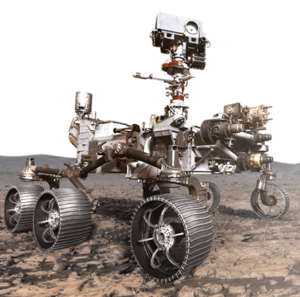Difference between revisions of "Template:Featured Article"
(Water) |
|||
| (26 intermediate revisions by 2 users not shown) | |||
| Line 1: | Line 1: | ||
| − | + | [[File:2020RoverArtistsConception.png|300px|left|Mars Perseverance Rover|link=Mars Perseverance Rover]] | |
| − | [[ | + | <div align="justify" style="text-align:justify;padding:0 5px;"> |
| − | + | NASA’s '''[[Mars Perseverance Rover]]''' (formerly Mars 2020) has a launch window from July 20 thru August 11, 2020 with a planned landing for February 18, 2021. The landing site selected is Jezero Crater at the coordinates 18.38°N 77.58°E, at nearly the same longitude as the Viking I lander in 1976. Perseverance has four major goals. The first goal is to determine whether life ever arose on Mars, the second goal is to characterize the climate of Mars, third is to characterize the geology of Mars, fourth and most importantly to prepare for human exploration of Mars. | |
| − | + | </div> | |
| + | <div align="justify" style="text-align:justify;padding:0 5px;"> | ||
| + | Perseverance, nicknamed Percy, was once thought of as a clone of MSL Curiosity, which landed in Gale crater in 2012. Some of the systems are the same and some have been updated with current technology. The 2020 rover is over 150 kg heavier than the MSL rover, weighing in at 1,025 kg. Perseverance will utilize the same landing system as Curiosity, the skycrane, which is enhanced with updated technology such as terrain relative navigation. This system will help Perseverance avoid landing in a dangerous area. Another new technology is the system called range trigger, which tells the parachute when to open in order for the rover to land in the desired landing spot. This technology saves time, as previous rovers had to land in a flat area and later drive to the more interesting targets. Perseverance has updated titanium wheels which include cleats and spokes as scientists discovered that Curiosity’s wheels were being damaged by the sharp rocks. The wheels for Perseverance were redesigned to withstand damage from the sharp rocks. | ||
| + | </div> | ||
| + | |||
<noinclude> | <noinclude> | ||
[[category:templates]][[category:Main Page Maintenance]] | [[category:templates]][[category:Main Page Maintenance]] | ||
</noinclude> | </noinclude> | ||
Revision as of 17:18, 3 July 2020
NASA’s Mars Perseverance Rover (formerly Mars 2020) has a launch window from July 20 thru August 11, 2020 with a planned landing for February 18, 2021. The landing site selected is Jezero Crater at the coordinates 18.38°N 77.58°E, at nearly the same longitude as the Viking I lander in 1976. Perseverance has four major goals. The first goal is to determine whether life ever arose on Mars, the second goal is to characterize the climate of Mars, third is to characterize the geology of Mars, fourth and most importantly to prepare for human exploration of Mars.
Perseverance, nicknamed Percy, was once thought of as a clone of MSL Curiosity, which landed in Gale crater in 2012. Some of the systems are the same and some have been updated with current technology. The 2020 rover is over 150 kg heavier than the MSL rover, weighing in at 1,025 kg. Perseverance will utilize the same landing system as Curiosity, the skycrane, which is enhanced with updated technology such as terrain relative navigation. This system will help Perseverance avoid landing in a dangerous area. Another new technology is the system called range trigger, which tells the parachute when to open in order for the rover to land in the desired landing spot. This technology saves time, as previous rovers had to land in a flat area and later drive to the more interesting targets. Perseverance has updated titanium wheels which include cleats and spokes as scientists discovered that Curiosity’s wheels were being damaged by the sharp rocks. The wheels for Perseverance were redesigned to withstand damage from the sharp rocks.







